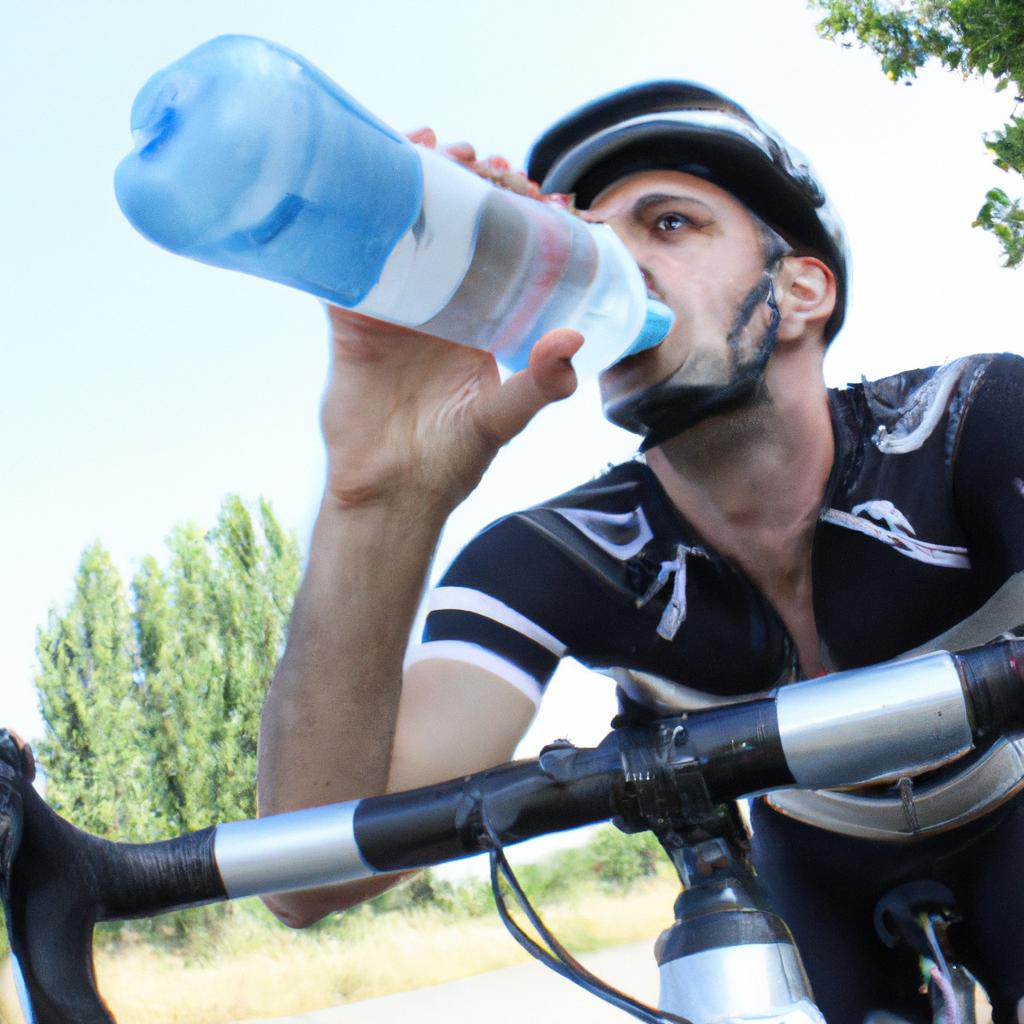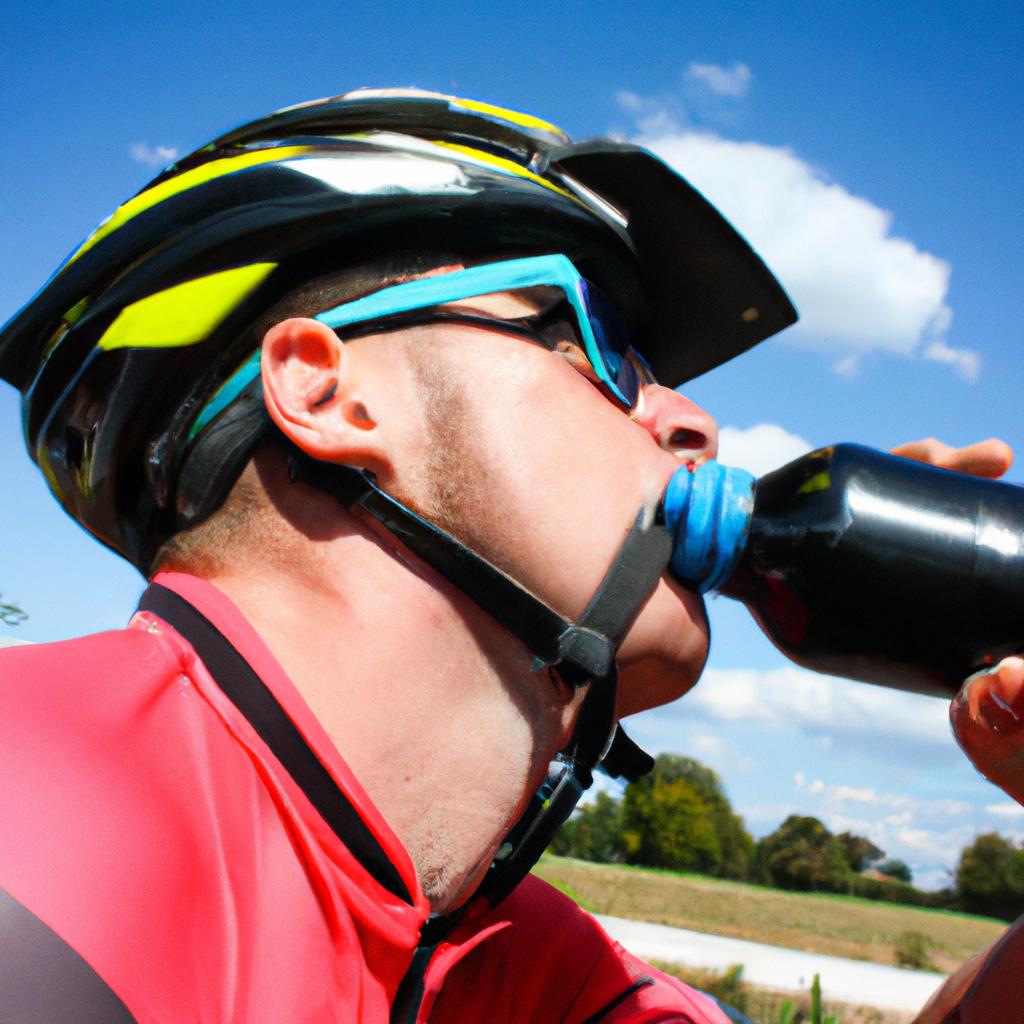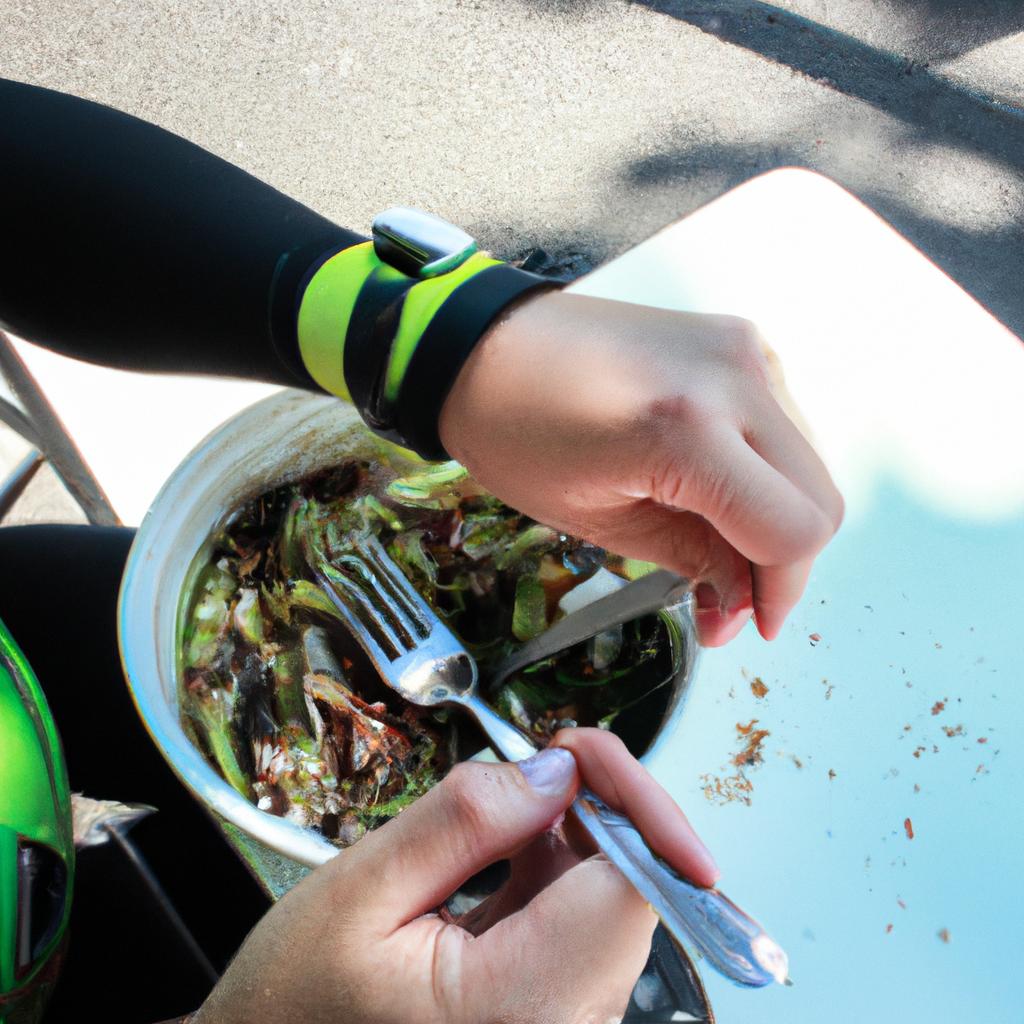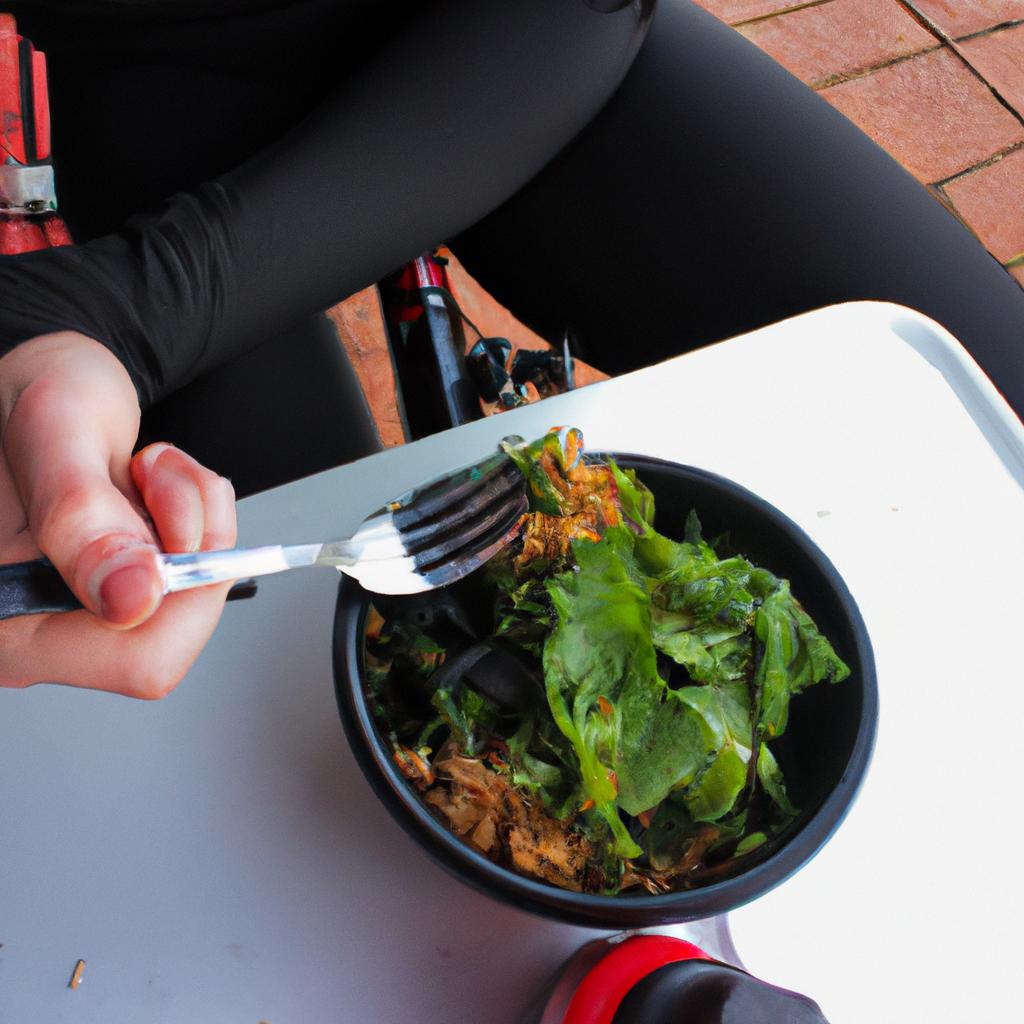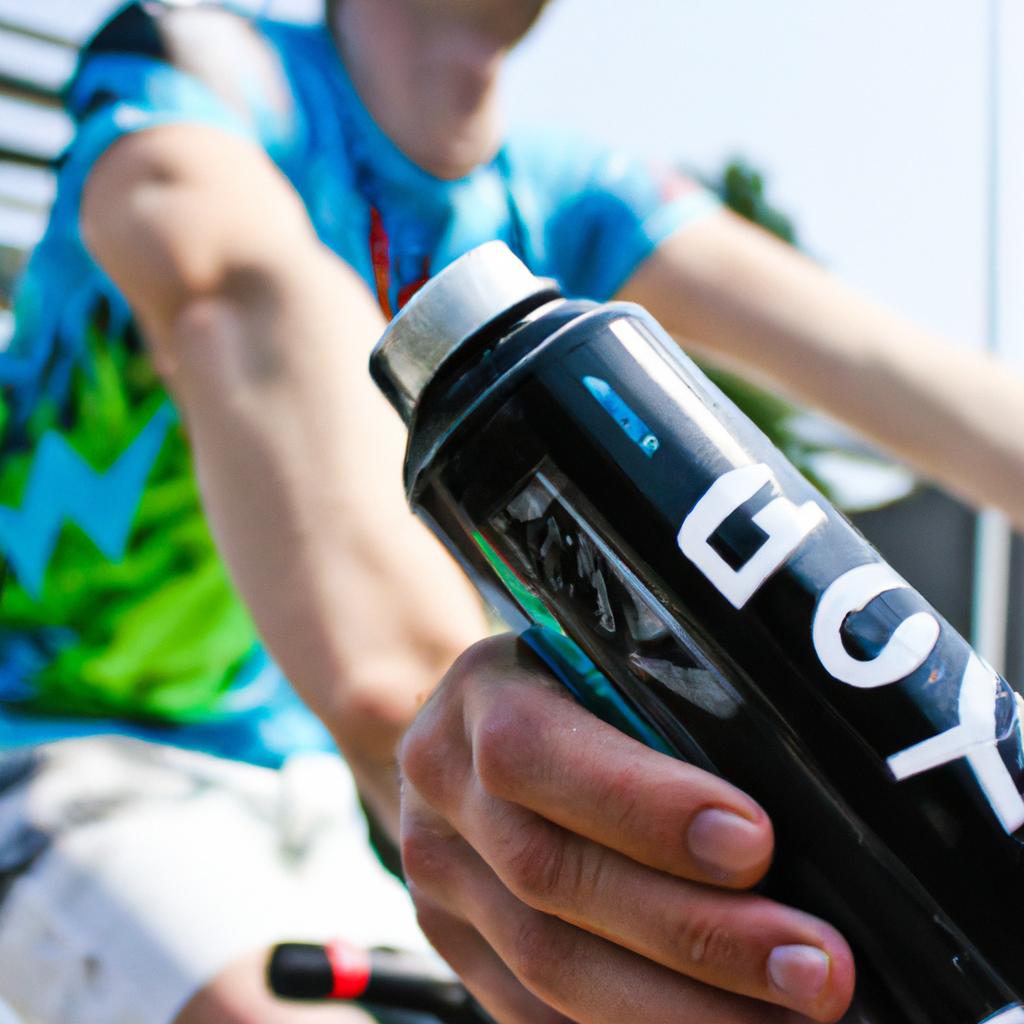Cycling Nutrition: Fueling Your Performance

Cycling nutrition plays a crucial role in optimizing athletic performance and endurance. Proper fueling of the body is essential for cyclists to meet the demands of their sport, as it directly impacts energy levels, recovery, and overall performance. For instance, imagine a hypothetical scenario where an amateur cyclist embarks on a long-distance race without adequately nourishing their body beforehand. As the kilometers pass by, they begin to experience fatigue, muscle cramps, and difficulty maintaining a steady pace. This example highlights the importance of understanding how nutrition choices can greatly influence cycling performance.
In order to achieve peak performance on the bike, cyclists must focus on consuming a balanced diet that provides adequate macronutrients such as carbohydrates, proteins, and fats. Carbohydrates are particularly important for cyclists as they serve as the primary source of fuel during intense exercise. By replenishing glycogen stores before and during rides through carbohydrate-rich foods like whole grains, fruits, and vegetables, cyclists can ensure optimal energy levels throughout their workouts or races. Additionally, protein intake should be sufficient to support muscle repair and growth after strenuous training sessions. Lean sources of protein such as poultry, fish, legumes, and dairy products are recommended to aid in proper recovery.
Furthermore, fat consumption should not be Furthermore, fat consumption should not be neglected in a cyclist’s diet. While carbohydrates are the main source of energy during exercise, fats play an important role in providing sustained energy for longer endurance rides. Healthy sources of fats such as avocados, nuts, seeds, and olive oil can be incorporated into meals to support overall energy balance.
In addition to macronutrients, cyclists should also pay attention to their micronutrient intake. Adequate amounts of vitamins and minerals are necessary for proper functioning of the body and optimal performance. Including a variety of fruits, vegetables, whole grains, and lean proteins in the diet can help ensure a wide range of essential nutrients.
Hydration is another critical aspect of cycling nutrition. Proper fluid intake before, during, and after rides is essential to prevent dehydration and maintain optimal performance. Water is typically sufficient for shorter rides, but for longer or more intense workouts or races, electrolyte-rich sports drinks may be beneficial to replenish electrolyte levels lost through sweat.
Timing is also important when it comes to nutrition for cyclists. Consuming a balanced meal or snack containing carbohydrates and protein within 1-2 hours before a ride can provide the necessary fuel for optimal performance. During longer rides, consuming easily digestible carbohydrate-rich snacks or sports gels at regular intervals can help maintain energy levels. After a ride, it’s important to refuel with a combination of carbohydrates and protein within 30 minutes to aid in muscle recovery.
It’s worth noting that individual needs may vary based on factors such as body composition, training load, intensity level, and personal preferences. Consulting with a registered dietitian who specializes in sports nutrition can provide personalized guidance tailored to specific goals and requirements.
Overall, paying attention to cycling nutrition is crucial for optimizing athletic performance by ensuring adequate fueling of the body before, during, and after rides. A balanced diet that includes appropriate amounts of macronutrients (carbohydrates, proteins, and fats), along with sufficient hydration and micronutrient intake, can help cyclists meet the demands of their sport and enhance their performance on the bike.
Importance of Proper Nutrition for Cyclists
Importance of Proper Nutrition for Cyclists
Imagine a scenario where two cyclists with similar training regimens compete in a challenging race. One cyclist, let’s call him Chris, is well-nourished and follows a carefully planned diet that optimizes his performance. The other cyclist, Sarah, neglects her nutrition and relies mainly on quick snacks and energy drinks during her rides. As the race progresses, it becomes evident that Chris effortlessly maintains his pace while Sarah struggles to keep up. This example underscores the significance of proper nutrition for cyclists.
The Impact of Nutrition on Performance:
Proper nutrition plays a crucial role in optimizing athletic performance for cyclists. A balanced diet with adequate macronutrients provides essential fuel for muscles and aids in recovery after intense workouts or races. By consuming the right amount of carbohydrates, proteins, and fats, cyclists can enhance their endurance levels, speed up recovery time, build muscle strength, and improve overall performance.
To further emphasize the importance of proper nutrition for cyclists, consider the following bullet points:
- Adequate carbohydrate intake replenishes glycogen stores in muscles and liver.
- Sufficient protein consumption repairs damaged muscle tissues.
- Healthy fat sources provide sustained energy during long rides.
- Hydration ensures optimal body functioning and prevents fatigue.
Impact of Poor Nutrition:
On the contrary, inadequate nutritional practices can lead to adverse effects on cycling performance. Insufficient carbohydrate intake may result in depleted glycogen stores, leading to premature fatigue during rides. Inadequate protein consumption hinders muscle repair and growth, potentially resulting in decreased power output and increased risk of injuries. Furthermore, an imbalanced intake of fats can impede energy utilization efficiency among cyclists.
To illustrate these potential consequences visually:
| Nutritional Deficiency | Consequence |
|---|---|
| Low Carbohydrate Intake | Decreased endurance |
| Inadequate Protein Intake | Reduced muscle repair and growth |
| Imbalanced Fat Intake | Impaired energy utilization efficiency |
Understanding the importance of proper nutrition is only the first step in optimizing cycling performance. In the subsequent section, we will delve into macronutrients such as carbohydrates, proteins, and fats to further explore their impact on cyclists’ overall well-being and athletic achievements. By examining these essential elements of a cyclist’s diet, we can gain actionable insights to fuel our performance effectively.
[Next Section: Macronutrients: Carbohydrates, Proteins, and Fats]
Macronutrients: Carbohydrates, Proteins, and Fats
Understanding the importance of proper nutrition for cyclists, let’s now delve into the different macronutrients that form the foundation of cycling nutrition. By fueling your body with the right combination of carbohydrates, proteins, and fats, you can optimize your performance on the bike.
Macronutrients are essential nutrients required in large amounts by our bodies to provide energy and support various bodily functions. Each macronutrient plays a unique role in enhancing athletic performance. For example, carbohydrates act as the primary source of fuel during exercise, providing readily available energy to power through those long rides. To maximize carbohydrate utilization, it is recommended that cyclists consume 6-10 grams per kilogram of body weight each day.
Proteins, on the other hand, aid in muscle repair and growth. Cyclists should aim for a protein intake of approximately 1.2-1.7 grams per kilogram of body weight daily to promote recovery and maintain lean muscle mass. Good sources of protein include lean meats, eggs, dairy products, legumes, and plant-based alternatives like tofu or tempeh.
Fats also have an important role in cycling nutrition as they serve as a secondary energy source during longer endurance rides when glycogen stores become depleted. Including healthy fats such as avocados, nuts, seeds, and olive oil in your diet can help provide sustained energy while supporting overall health.
- Enhance your cycling performance with proper macronutrient balance
- Optimize carbohydrate intake to power through rigorous training sessions
- Promote muscle repair and growth with adequate protein consumption
- Include healthy fats for sustained energy during long rides
Below is a table highlighting some common food sources rich in each macronutrient:
| Macronutrient | Food Sources |
|---|---|
| Carbohydrates | Whole grains |
| Fruits | |
| Vegetables | |
| Legumes | |
| Proteins | Lean meats |
| Eggs | |
| Dairy products | |
| Plant-based alternatives | |
| Fats | Avocados |
| Nuts and seeds | |
| Olive oil |
Understanding the role of macronutrients in cycling nutrition is crucial, but it’s equally important to stay fueled and hydrated during your rides. Let’s explore the next section on hydration and discover how to maintain optimal performance throughout your cycling journeys.
Hydration: Staying Fuelled and Hydrated
Having discussed the importance of macronutrients in fueling your cycling performance, let us now turn our attention to another crucial aspect of nutrition – hydration.
To emphasize the significance of staying hydrated during cycling, consider this hypothetical scenario: Imagine a cyclist who fails to drink enough fluids before embarking on a long-distance ride. As they pedal along, their body starts to lose water through sweat, leading to dehydration. This not only affects their physical performance but also impairs cognitive function, making it difficult for them to make quick decisions or maintain focus on the road ahead.
To prevent such situations and optimize your cycling performance, here are some key factors to keep in mind:
- Fluid intake: Adequate fluid intake is essential both before and during your rides. Aim to consume at least 500 ml (about 17 ounces) of water or a sports drink two hours prior to cycling. During your ride, try to take small sips every 15–20 minutes.
- Electrolyte balance: Sweating leads to the loss of electrolytes like sodium and potassium from your body. It’s important to replenish these electrolytes by consuming drinks that contain appropriate amounts of minerals or by adding electrolyte tablets or powders to your water bottle.
- Environmental conditions: Adapt your hydration strategy based on weather conditions. Hot and humid environments increase sweating rates, requiring you to consume more fluids compared to cooler climates.
- Monitoring urine color: A simple way to gauge your hydration status is by observing the color of your urine. Light yellow or pale straw-colored urine indicates adequate hydration, while dark yellow signifies possible dehydration.
| Factors affecting Hydration |
|---|
| Fluid Intake |
| Electrolyte Balance |
| Environmental Conditions |
| Urine Color |
Incorporating these practices into your cycling routine will help ensure you stay fueled and hydrated throughout your rides, optimizing performance and reducing the risk of fatigue-induced errors.
“.
Pre-ride Nutrition: Fueling Up Before Cycling
Building upon the importance of hydration, let’s now delve into another crucial aspect of cycling nutrition – pre-ride fueling. To better understand its significance, consider the following scenario:
Imagine a cyclist named Sarah who is preparing for an intense endurance race. She has been diligently hydrating throughout her training but realizes that she also needs to focus on providing her body with optimal energy before embarking on such physical exertion.
To maximize performance and minimize fatigue during a cycling session, it is essential to properly fuel your body beforehand. Here are some key considerations when planning your pre-ride nutrition strategy:
- Timing: Aim to consume a balanced meal or snack containing carbohydrates, protein, and healthy fats about 2-3 hours before cycling. This allows sufficient time for digestion while ensuring sustained energy release during exercise.
- Carbohydrates: Prioritize consuming complex carbohydrates like whole grains, fruits, and vegetables as they provide long-lasting energy by gradually releasing glucose into the bloodstream.
- Protein: Including lean sources of protein such as chicken breast or Greek yogurt can aid in muscle repair and recovery after intense workouts.
- Fluids: Hydration should not be neglected even before taking off on your bike. Ensure you have consumed enough fluids leading up to your ride to maintain proper hydration levels.
Table – Pre-Ride Nutrition Guidelines:
| Considerations | Recommendations |
|---|---|
| Timing | Consume meal/snack 2-3 hours prior to riding |
| Carbohydrates | Opt for complex carbs |
| Protein | Include lean sources |
| Fluids | Stay hydrated |
By implementing these guidelines into her routine, Sarah can optimize her performance by adequately fueling herself before hitting the road. Remember, effective pre-ride nutrition sets the foundation for a successful cycling experience.
As crucial as pre-ride nutrition is, it’s equally important to sustain energy levels during your ride. Let us now explore the significance of maintaining adequate nutrition while cycling in the next section: “During-Ride Nutrition: Maintaining Energy Levels.”
During-ride Nutrition: Maintaining Energy Levels
Transitioning from the importance of pre-ride nutrition, it is crucial to focus on maintaining energy levels during your cycling session. Let’s consider an example – imagine you are embarking on a long-distance ride through challenging terrain. As you pedal uphill, the intensity increases and your body demands more fuel to sustain performance. This section will outline key strategies for optimizing your nutrition intake during rides.
To ensure adequate sustenance throughout your ride, there are several considerations:
- Hydration: Staying hydrated is vital in preventing fatigue and cramps. Aim to consume water or electrolyte-rich sports drinks at regular intervals to replenish lost fluids and minerals.
- Carbohydrate intake: Cycling requires a steady supply of carbohydrates as they provide readily available energy. Consume easily digestible snacks such as energy gels, bars, or fruits like bananas that can be conveniently consumed during breaks without hindering your pace.
- Electrolyte balance: Along with hydration, maintaining proper electrolyte balance is essential for optimal muscle function and endurance. Foods rich in sodium (e.g., pretzels) or potassium (e.g., oranges) can help replenish these vital minerals.
- Timing: Strategically plan when to eat during longer rides based on the duration and intensity of exercise. Eating smaller portions frequently rather than consuming larger meals ensures a consistent flow of nutrients without causing discomfort.
| Snack | Benefits | Recommended Quantity |
|---|---|---|
| Energy gel | Quick source of glucose | 1 packet |
| Trail mix | Combination of carbs & fats | Handful |
| Peanut butter | High-calorie protein source | 1 tablespoon |
| Recovery drink | Replenishes glycogen stores | 8 ounces |
In summary, maintaining energy levels while cycling involves staying properly hydrated, consuming adequate carbohydrates and electrolytes, and timing your intake strategically. By following these guidelines, you can optimize your performance and sustain the necessary energy levels throughout your ride.
Transitioning into our next section on post-ride nutrition, it is essential to focus on recovery and repair after a demanding cycling session.
Post-ride Nutrition: Recovery and Repair
Transitioning from the importance of maintaining energy levels during a ride, post-ride nutrition is equally crucial for cyclists. Proper recovery and repair after intense physical activity can significantly impact performance in subsequent rides. To illustrate this point, let’s consider the case of Alex, an avid cyclist who recently completed a challenging 100-kilometer race.
After crossing the finish line, Alex knew that refueling his body was essential to aid in muscle recovery and replenish depleted glycogen stores. Post-ride nutrition plays a vital role in repairing damaged muscles, reducing inflammation, and promoting overall recovery. By prioritizing proper nutrition immediately after the race, riders like Alex can optimize their ability to bounce back quickly and perform at their best in future events.
To ensure effective post-ride nutrition, it is important to focus on key elements such as:
- Rehydration: Hydration levels may be compromised during prolonged cycling sessions due to excessive sweating. It is crucial to replace lost fluids by consuming adequate amounts of water or electrolyte-rich beverages.
- Carbohydrate Intake: Consuming carbohydrates within the first 30 minutes after completing a ride helps restore glycogen stores more efficiently. Foods like bananas, whole grains, or sports drinks are excellent choices.
- Protein Consumption: Adequate protein intake promotes muscle repair and growth following intense exercise. Including lean sources of protein like chicken breast or tofu alongside carbohydrate-rich foods aids in optimal recovery.
- Antioxidant-Rich Foods: Incorporating fruits and vegetables into post-ride meals provides essential antioxidants that help combat oxidative stress caused by strenuous exercise.
To better understand the significance of these nutritional considerations, refer to the table below which highlights some benefits associated with specific nutrients:
| Nutrient | Benefits |
|---|---|
| Carbohydrates | Rapid glycogen restoration |
| Proteins | Muscle repair |
| Electrolytes | Optimal hydration |
| Antioxidants | Reduced inflammation |
By incorporating these key elements into their post-ride nutrition routine, cyclists can maximize recovery and prime their bodies for future training sessions or races. Remember, proper nourishment after a ride is not just about refueling; it’s about optimizing performance in the long run.
In summary, effective post-ride nutrition is essential for athletes like Alex to promote muscle repair, reduce inflammation, and replenish depleted energy stores. By focusing on rehydration, carbohydrate intake, protein consumption, and antioxidant-rich foods, cyclists can enhance their recovery process and prepare themselves for subsequent rides. Emphasizing these nutritional considerations will foster optimal performance and overall well-being in the world of cycling.

